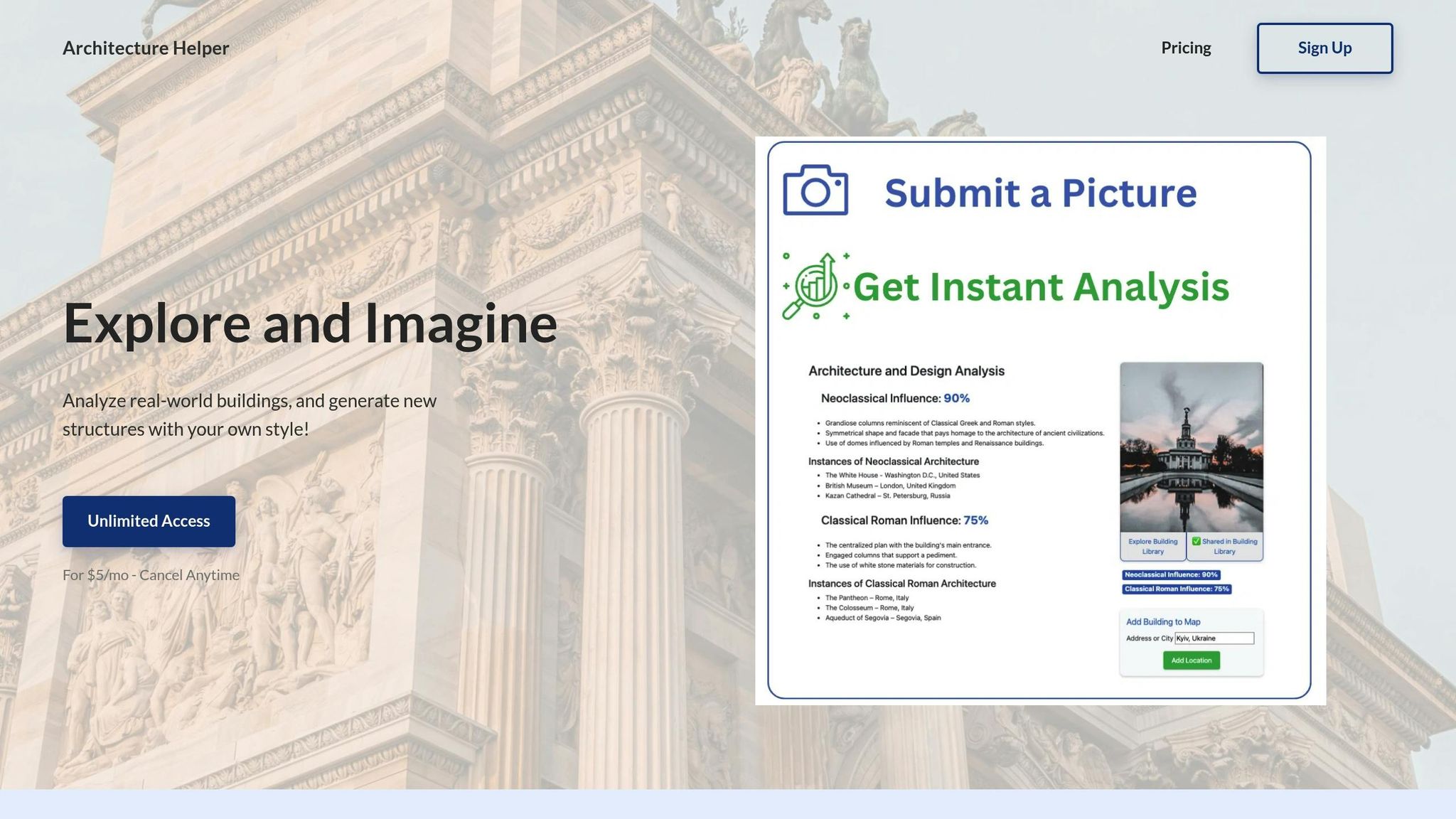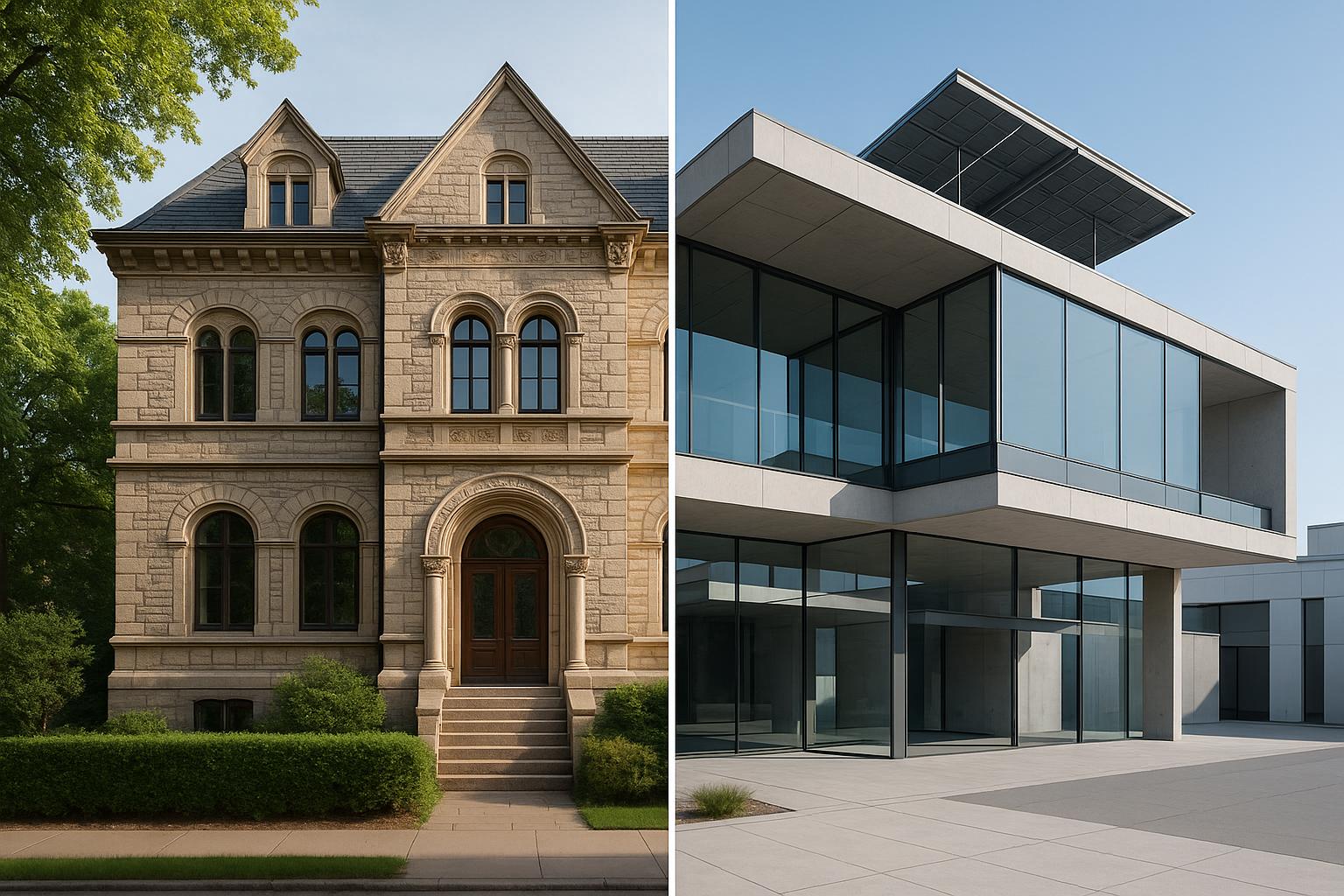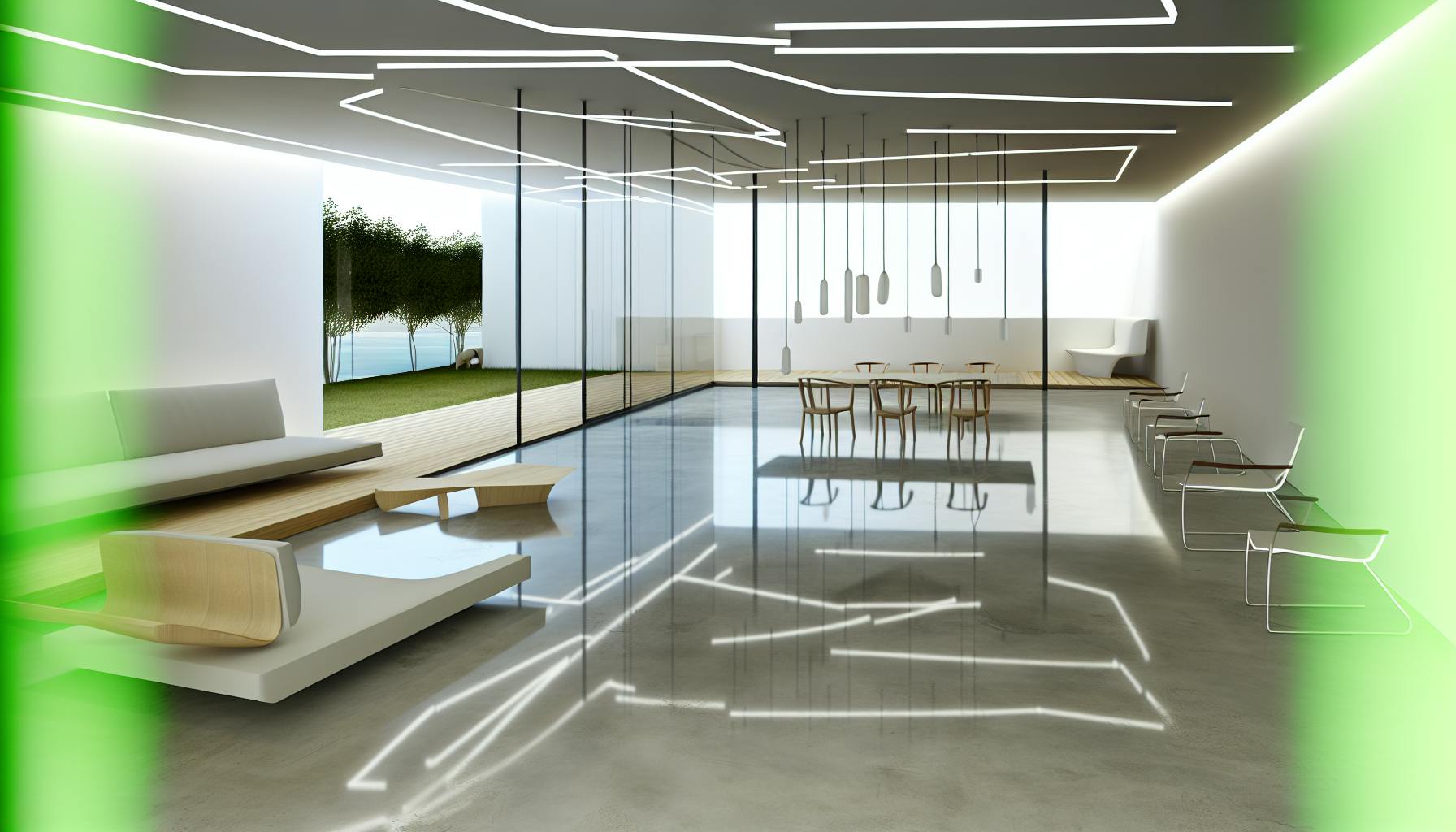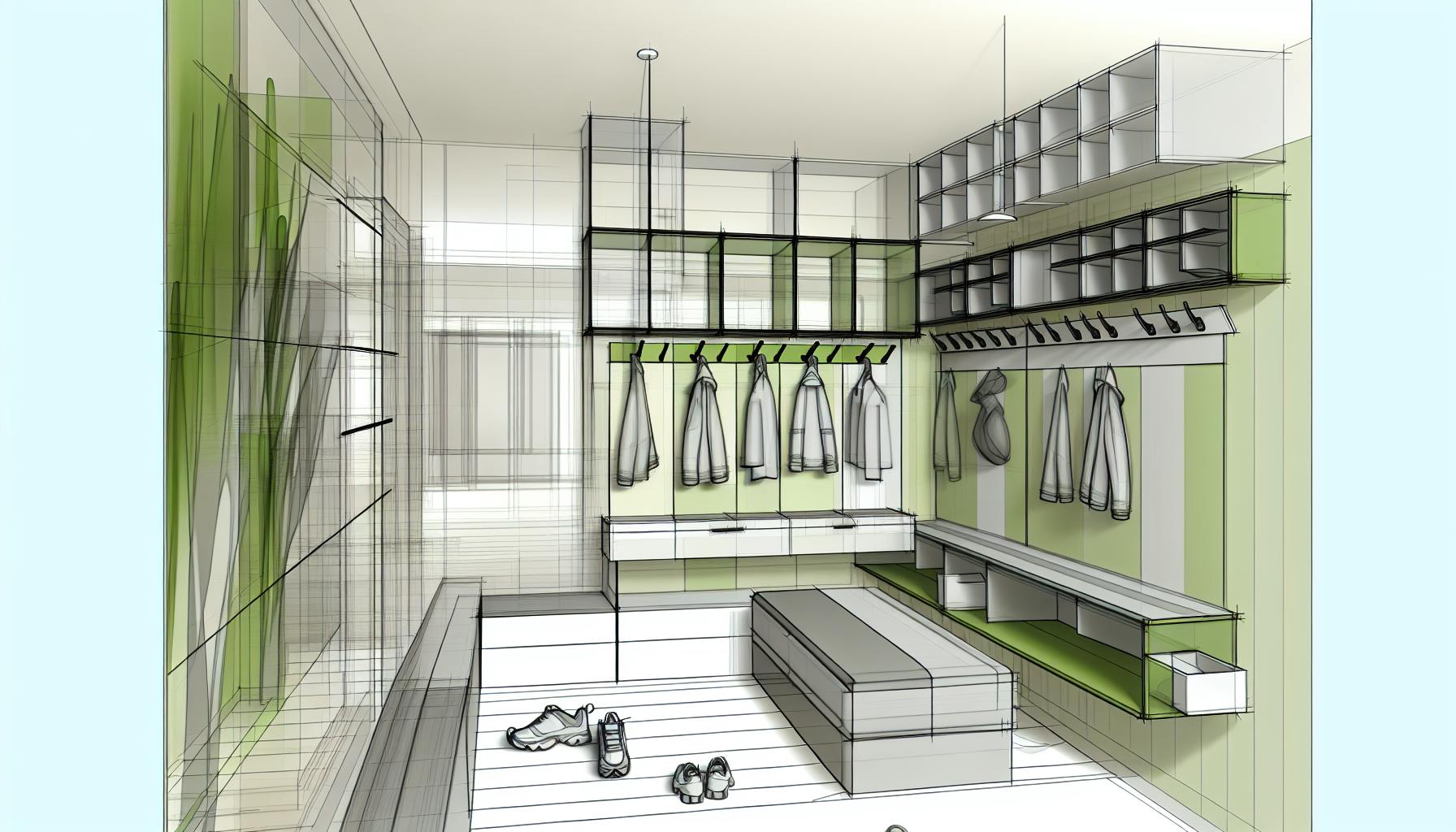AI is transforming biophilic architecture by merging data-driven insights with nature-inspired design. This approach creates spaces that improve well-being, productivity, and environmental performance. Here's what you need to know:
- Biophilic Design Basics: Incorporates natural light, greenery, water features, and organic materials to connect people with nature.
- AI's Role:
- Generative Design: Produces organic, efficient structures by analyzing materials and environmental factors.
- Data Analysis: Evaluates climate, biodiversity, and user behavior to optimize designs.
- Simulations: Predicts how designs will perform in real-world settings.
- Benefits: Improved mental and physical health, productivity boosts (e.g., 15% in offices), and reduced energy use.
- Challenges: High initial costs, skill gaps, and ethical concerns around AI reliance.
AI tools like Architecture Helper streamline workflows, enabling architects to design spaces that prioritize human well-being while addressing ecological needs. The future lies in balancing AI precision with human intuition to create spaces that connect us to the natural world.
Biophilic Design: Basic Principles and Why It Matters
Core Principles of Biophilic Architecture
Biophilic architecture is shaped by six principles introduced by Stephen R. Kellert, aiming to strengthen our bond with nature. These principles are divided into two categories: direct experiences with nature and indirect experiences that bring natural patterns and materials into our surroundings.
Direct experiences involve physical interactions with nature. This includes maximizing natural light through well-placed windows, integrating living plants with features like green walls and vertical gardens, adding calming water features, and providing access to views of outdoor landscapes. These elements create a tangible connection to the natural world.
Indirect experiences focus on incorporating nature-inspired patterns, materials, and forms into design. This might involve using organic materials like wood, stone, or bamboo, mimicking natural forms and processes through biomimicry, or incorporating nature-themed artwork and digital displays.
"Biophilic design is the deliberate attempt to translate an understanding of the inherent human affinity to affiliate with natural systems and processes known as biophilia...into the design of the built environment." - Stephen R. Kellert
The California Academy of Sciences in San Francisco is a standout example of biophilic design. Its living roof, covered in native plants, provides insulation, reduces stormwater runoff, and supports biodiversity. The building's extensive use of glass allows natural light to flood the interiors, while indoor gardens and exhibits highlight various ecosystems.
Similarly, Bosco Verticale in Milan, Italy, brings nature directly to residents. These two residential towers are home to over 20,000 plants and 900 trees, creating a "vertical forest" that improves air quality, reduces noise pollution, and fosters a closer connection to nature for its inhabitants.
These principles not only influence aesthetics but also contribute to real, measurable benefits for both human health and the environment.
Why Biophilic Design Matters Today
Biophilic design delivers clear benefits in productivity, health, and environmental outcomes, making it an essential approach in modern architecture. Research consistently highlights the positive effects of natural elements on both mental and physical well-being.
Productivity and cognitive function see notable improvements in biophilic spaces. For example, studies show that adding plants to a plain office increased productivity by 15%, while employees in green-certified buildings experienced a 26% boost in cognitive performance and reported greater job satisfaction .
Health benefits are equally compelling. Workspaces with ample daylight access reported 18% fewer sick days for employees. In healthcare environments, brighter rooms with natural light contributed to a 26-41% reduction in hospital stays. Additionally, access to outdoor views has been linked to a 10-15% improvement in mental function and memory recall.
The physical effects are just as striking. Natural light and greenery help increase serotonin levels, which regulate mood, while reducing cortisol, the stress hormone. This calming effect lowers heart rates and blood pressure, fostering better cardiovascular health .
Environmental performance also improves with biophilic design. For instance, schools that adopted displacement ventilation systems saw a 69% decrease in asthma cases, and natural ventilation led to a 16.7% reduction in doctor visits.
"Biophilic design exemplifies the notion that spaces should be cultivated for enhancing public health and nurturing humans' innate desire to feel connected to natural systems." - BlueGreen Alliance Foundation
As urbanization increasingly distances people from natural environments, biophilic design offers a way to bring nature back into daily life. Beyond aesthetics, it creates spaces that promote well-being, reduce stress, and boost creativity. From faster healing in hospitals to improved focus in schools and workplaces, the benefits of biophilic design are both practical and far-reaching.
For architects and designers, tools like Architecture Helper provide case studies and practical tips for integrating natural elements into various architectural styles, offering inspiration and guidance for incorporating these impactful design strategies into future projects.
Nilanjan Bhowal: Biophilic Design and Sensory-Driven Architecture | Incredible India Series
AI Technologies Changing Biophilic Architecture
AI is reshaping biophilic architecture by streamlining design processes and making sense of vast datasets. Its influence spans across three key areas: generative design, data analysis, and simulation tools.
Generative Design for Nature-Inspired Structures
Generative design, powered by AI, takes cues from nature to create organic, efficient forms. By analyzing factors like material usage, structural integrity, and environmental adaptability, AI generates a multitude of design possibilities.
One standout example is Airbus's bionic partition for the A320. Using algorithms inspired by slime mold and mammal bones, the generative design software produced partitions that are 66 pounds lighter than standard ones. This weight reduction translates to up to 1,100 fewer pounds per aircraft and cuts annual CO2 emissions by approximately 166 metric tons (183 short tons).
"I'm a mechanical engineer with more than 30 years of experience, and I see here the biggest change I've ever seen. Every one of us has to understand a new way of working."
– Peter Sander, Airbus
Generative design isn't limited to aerospace. Zaha Hadid Architects applied this approach to the Morpheus Hotel in Macau, designing an exoskeleton inspired by bamboo shoots. This structure optimizes load distribution and reduces the need for internal supports.
AI's ability to uncover unexpected design solutions is particularly useful for biomimetic architecture. For instance, architects can use text prompts to describe natural elements they want to incorporate, and AI platforms can produce detailed, realistic visualizations.
"The thing that excites me the most about integrating generative AI into architectural practice is that the technology is becoming a collaborative partner in the design process."
– Professor Emily C.S. Pellicano, Syracuse University School of Architecture
Data Analysis for Better Design Decisions
AI revolutionizes how architects analyze environmental and user data, enabling the creation of healthier and more effective biophilic spaces. By processing site-specific data quickly, AI provides actionable insights for design strategies.
One of its key applications is climate analysis. AI can recommend plant species based on factors like sunlight, temperature, and humidity, ensuring that greenery thrives in its environment.
Researchers like Afroz et al. have developed frameworks to optimize façade designs, balancing natural light, energy efficiency, and aesthetics. These AI-informed façades outperform traditional designs. Moreover, AI can predict the psychological impact of biophilic elements by analyzing landscapes and estimating Total Environment Quality (TEQ). Studies show that spaces labeled with nature-related elements improve psychological outcomes significantly.
In another example, Yang et al. trained deep learning models using room images to predict visual comfort. By analyzing features like plant placement, lighting, and color schemes, AI enables architects to optimize biophilic designs before construction even begins. Additionally, AI can monitor air quality, moisture, and temperature, allowing designs to evolve based on real-time performance data.
Simulation Tools for Predicting Design Performance
Simulation tools powered by AI take data analysis a step further, allowing architects to predict how designs will perform in real-world scenarios. These tools simulate variables like sunlight, wind, and energy use, helping refine designs before construction starts.
For instance, Autodesk Forma uses large datasets to model and compare different design scenarios, enabling architects to make smarter choices about site planning, energy efficiency, and environmental impact. Similarly, Sidewalk Labs combines AI, machine learning, and sensor technology to optimize building performance. By analyzing real-time data on traffic, air quality, and noise, it helps architects seamlessly integrate biophilic elements into their designs.
Space Syntax takes a different angle, simulating pedestrian and vehicle movement to optimize spatial layouts for urban and building designs.
These tools also provide insights into human responses to biophilic elements. Eye-tracking studies, for example, reveal that curved and fractal patterns on facades draw more attention than linear designs. Additionally, cognitive research shows that environments with natural lighting and plants enhance brain activity, particularly in areas linked to executive function, improving focus and productivity.
With these simulation capabilities, architects can ensure that biophilic designs meet performance goals while minimizing costly post-construction adjustments. The result? Spaces that balance environmental efficiency with human well-being.
Step-by-Step AI Workflow for Biophilic Design
AI takes raw environmental data and transforms it into nature-integrated designs through a structured, three-phase workflow. This process combines analysis and creativity to create spaces that blend seamlessly with natural systems.
Site and Context Analysis
The first step in biophilic design is to thoroughly understand the site and its environment. AI plays a key role here, quickly uncovering patterns like sunlight exposure, temperature shifts, wind directions, and humidity levels that shape the design process.
At the core of this phase is Environmental Data Processing. AI systems can evaluate climate data - sunlight patterns, temperature fluctuations, humidity, and wind conditions - while also assessing microclimates that affect how natural elements perform on-site.
Another critical step is the Biodiversity Assessment, where AI identifies existing plant species, evaluates soil conditions, and analyzes the health of local ecosystems. This helps architects understand which natural elements already thrive and how new biophilic features can complement them.
In urban planning, AI integrates demographic, traffic, and environmental data to design layouts that enhance green spaces and ecological connections. For example, AI might pinpoint pedestrian flow patterns to recommend ideal spots for green corridors or identify areas where natural light benefits both plants and people.
AI also refines the plant selection process by analyzing sunlight, temperature, and humidity. This ensures the chosen species are well-suited to the site’s climate, increasing the likelihood that biophilic elements will thrive long-term.
This detailed analysis lays the groundwork for creating informed, data-driven designs.
Idea Generation and Form Development
After the site analysis, AI shifts into its creative role, crafting design concepts that align with environmental data and biophilic principles.
Using generative algorithms, AI produces multiple design iterations based on site data and project constraints. These iterations balance factors like connectivity, biodiversity, and accessibility, creating layouts that maximize natural integration.
Through Nature-Inspired Pattern Generation, AI can design organic forms and textures that mimic natural processes. For instance, building facades might feature shapes, patterns, and textures inspired by nature, or even living walls. These designs not only soften the urban landscape visually but also serve functional purposes, like improving airflow or maximizing natural light.
Real-world examples highlight the value of this approach, particularly in urban planning. AI also supports Participatory Design Integration by analyzing community feedback. This creates a loop where residents’ input shapes and refines the final design, ensuring it aligns with human needs and preferences.
AI’s ability to rapidly iterate allows for continuous design improvements, blending creative ideas with practical performance data.
Visualization and Design Refinement
Once design concepts are generated, the final phase focuses on turning ideas into detailed, testable visual models.
AI creates photorealistic 3D renderings that showcase lighting, materials, and the surrounding environment. These renderings, combined with performance simulations, help stakeholders visualize and evaluate designs before construction begins. Simulations also reveal how design elements might affect ecosystems and biodiversity.
Research by Shih-Han Hung and Chun-Yen Chang at the University of Auckland’s Future Cities Research Hub highlights AI’s predictive capabilities. Their study used AI to analyze landscape elements, showing that nature-inspired designs significantly improve psychological well-being compared to urban designs.
Virtual reality (VR) and augmented reality (AR) tools allow stakeholders to explore designs in 3D, offering valuable feedback on biophilic features before they’re finalized.
Adaptive Refinement is a continuous optimization process where AI incorporates new data and feedback to fine-tune designs. This could mean adjusting lighting, furniture, or landscaping to enhance both environmental performance and human comfort.
Platforms like Architecture Helper further enhance this workflow by offering a library of analyzed biophilic designs and architectural elements. These resources let designers experiment with proven strategies and innovative combinations, enriching their AI-driven process.
This streamlined workflow highlights how AI simplifies complex design challenges while preserving the essential connection between humans and nature that defines successful biophilic spaces.
sbb-itb-1be9014
Practical Examples and Case Studies
AI is making its mark in biophilic architecture by turning theoretical concepts into practical applications. These innovations not only elevate the quality of urban spaces but also boost environmental performance and improve the well-being of those who inhabit them.
Designs That Adapt to Changing Conditions
AI-driven platforms are transforming urban planning by combining sensor data, machine learning, and generative design. These tools are creating designs that adapt to specific site conditions, regulatory requirements, and environmental changes. For example, they help optimize energy efficiency, safety, and comfort by dynamically adjusting biophilic elements like greenery and natural lighting. This adaptability ensures that sustainable systems remain effective over time, while also enhancing the health and comfort of occupants.
Enhancing Health and Well-Being with AI
AI doesn’t just improve design flexibility - it also directly impacts occupant health. Researchers Shih-Han Hung and Chun-Yen Chang used AI to study landscape elements and their effects on Total Environment Quality (TEQ). Their findings showed that spaces incorporating natural features significantly improve psychological well-being compared to urban-dominated environments.
This is especially relevant in workplace design. For instance, a survey of UK office workers revealed concerning statistics: 25% felt their environment didn’t support their well-being, while dissatisfaction was linked to a lack of color (80%), greenery (64%), and art (61%). Shockingly, 58% of the 7,600 workers surveyed reported having no plants in their offices. AI tools are stepping in to address these gaps by simplifying floor plan generation and speeding up design cycles, making it easier to create spaces that promote well-being.
Platforms Like Architecture Helper

Platforms such as Architecture Helper are making biophilic design more accessible and actionable for architects. This digital tool offers a rich library of analyzed biophilic strategies, allowing architects to explore, iterate, and refine their designs. With features that let users mix and match natural elements, the platform supports the creation of hybrid designs tailored to specific site conditions and user needs. This iterative approach helps architects meet both environmental goals and wellness objectives in their projects.
These tools and strategies are empowering architects to design spaces that are not only efficient but also deeply connected to nature, ensuring better outcomes for both people and the planet.
Benefits and Challenges of AI in Biophilic Architecture
Integrating AI into biophilic architecture presents exciting possibilities alongside some notable hurdles. By 2024, it's estimated that 68% of architectural firms will be actively exploring or using AI-driven tools, with many already reporting improved workflows. However, the picture isn’t entirely straightforward. While the adoption rates sound promising, the reality involves a mix of benefits and challenges that touch on financial, technical, and societal factors.
Comparison of Pros and Cons
| Benefits | Challenges |
|---|---|
| Enhanced Creativity: AI can analyze vast datasets to propose unexpected design concepts, inspiring new creative directions | Loss of Human Intuition: Over-reliance on AI risks creating designs that feel generic or lack a personal touch |
| Increased Efficiency: AI tools can boost workflow efficiency by 25-30% in architectural processes | Skill Gap: Only 6% of architects use AI regularly, and 60% lack formal training in these tools |
| Cost Savings: Sustainability features powered by AI can reduce energy use and carbon emissions by up to 20% | High Initial Costs: Basic AI projects cost $50,000-$100,000, with complex ones exceeding $5 million |
| Improved Accuracy: AI helps catch errors in plans and construction documents, minimizing costly mistakes | Data Dependence: Flawed or biased data can lead to unreliable design suggestions |
| Better Project Management: AI enhances scheduling, resource allocation, and communication | Integration Issues: AI tools can face compatibility problems with existing systems |
| Sustainable Solutions: AI recommends energy-efficient materials and designs tailored to biophilic principles | Ethical Concerns: Questions arise around job loss, design ownership, and accountability for AI-generated errors |
For example, Smart Design Studio reported a 30% reduction in environmental analysis and structural optimization time after implementing AI, which directly cut project costs. Similarly, AI-driven sustainability efforts have led to measurable environmental gains, such as reducing energy use and emissions by up to 20%.
Despite these benefits, the financial barrier remains significant. Initial AI investments can range from $50,000 to over $5 million, with additional costs for updates and employee training. Yet, firms that embrace AI often see a strong return on investment through improved efficiency. Dr. Alan Grant, a Consultant in Architectural Technology, highlights this balance:
"While the initial investment in AI can be daunting, the potential for cost savings and efficiency gains can make it a wise financial decision for many architectural firms."
Adoption rates also reveal a gap between interest and action. While many firms express enthusiasm for AI, only 28% have actively implemented it into their practices. This hesitation often stems from a lack of training. Interestingly, younger architects tend to express more concerns about AI's role in architecture, possibly due to firsthand experience with its limitations. This generational perspective underscores the need for robust training programs that address both the technical and creative aspects of AI.
Joseph Choma, Director of Florida Atlantic University's School of Architecture, offers a balanced view:
"AI is not a replacement for creativity but a tool that enhances it."
The success of AI in biophilic design hinges on thoughtful implementation. While AI excels at gathering data and monitoring environmental conditions over time, architects must remain actively involved to ensure the designs maintain their unique, human-centered qualities.
Cultural and community factors also play a significant role. AI tools may struggle to grasp local cultural nuances, which can lead to designs that fail to resonate with the people they’re meant to serve. This is especially critical in biophilic architecture, where the connection to local ecosystems and cultural relationships with nature is essential.
To navigate these challenges, architectural firms and institutions must adopt a comprehensive approach. This includes continuous training, ethical guidelines, and fostering a mindset of critical thinking. Rather than treating AI as a standalone solution, successful firms use it as a complement to human expertise, preserving the creativity and intuition that define meaningful architecture.
Conclusion: The Future of AI in Biophilic Architecture
The combination of AI and biophilic design is reshaping how we create spaces that bring people closer to nature. As discussed throughout this guide, AI's ability to quickly process user data and environmental factors allows architects to craft designs that promote healthier, more inspiring environments for living, working, and learning. This shift is influencing every stage of the design process.
From initial site analysis to refining the final design, AI plays a key role in tackling complex challenges while embracing the intricacies of nature. As Michael Pawlyn emphasizes, architecture should always prioritize people.
AI tools can now recommend the best plant species for different climates, simulate natural light and green space placement using VR, and make real-time adjustments to lighting, air quality, and temperature. These advancements even extend to predicting health benefits, as AI evaluates landscape features to calculate Total Environment Quality (TEQ). Spaces with natural elements have been shown to significantly boost psychological well-being.
Despite these capabilities, only 28% of architectural firms have adopted AI into their workflows. Chris Metropulos from Deltek highlights the potential of this technology:
"The future of architecture isn't about AI replacing human creativity - it's about AI enhancing it. When we automate routine tasks, we create more space for innovation, allowing architects to focus on what they do best: designing spaces that create lasting value."
For architects new to AI, starting with tools for site and environmental analysis is a practical first step. Platforms like Architecture Helper can serve as an entry point, offering resources to explore biophilic designs and experiment with various natural elements to inspire fresh ideas.
Looking ahead, success will depend on balancing the precision of technology with the intuition of human creativity. As Pawlyn wisely advises:
"Never start with reality: always start by identifying the ideal and compromise as little as necessary"
AI provides architects with the means to pursue those ideals, creating spaces that nurture both human well-being and a deeper connection to the natural world.
The future of biophilic architecture lies in harmonizing human creativity with artificial intelligence, paving the way for a sustainable and balanced built environment.
FAQs
How does AI enhance mental and physical well-being in biophilic architecture?
AI is transforming biophilic architecture by shaping spaces designed to enhance mental and physical well-being. When it comes to mental health, AI evaluates emotional and sensory reactions to craft environments that foster a stronger connection to nature. These spaces often incorporate elements like lush greenery, flowing organic shapes, and calming textures, helping to lower stress levels and improve concentration.
On the physical health side, AI fine-tunes building layouts to make the most of natural light and outdoor views. This approach can lead to better sleep, ease symptoms of Seasonal Affective Disorder (SAD), and even speed up recovery times in healthcare facilities. By combining cutting-edge technology with nature-inspired principles, AI contributes to creating spaces that promote wellness while maintaining a balance with the natural world.
What ethical challenges arise from using AI in biophilic design, and how can they be managed?
The integration of AI into biophilic design brings up some important ethical challenges, including algorithmic bias, privacy concerns, the potential loss of human creativity, and over-reliance on automation. These issues can influence how fair, inclusive, and original architectural designs turn out.
To navigate these challenges, it’s crucial to implement ethical AI practices. This means being transparent about how algorithms are created, conducting thorough testing to reduce bias, and establishing clear systems for accountability. Additionally, maintaining human oversight throughout the design process is key. This ensures that creativity and ethical decision-making remain central, even as we utilize AI to enhance the design process.
How can architects address high costs and skill gaps when using AI in biophilic architecture?
Cutting Costs and Bridging Skill Gaps in AI-Driven Biophilic Design
High costs and a lack of expertise can make AI-driven biophilic design seem out of reach for many architects. But there are practical ways to overcome these challenges.
One approach is to use cost-effective AI tools and services. Scalable, pay-as-you-go cloud platforms and serverless computing are great options. These systems let architects tap into advanced AI capabilities without requiring hefty upfront investments, making them a smart choice for budget-conscious projects.
AI tools can also simplify the design process by automating repetitive tasks or optimizing layouts. This not only saves time but makes complex techniques easier to implement. For architects who are just starting with AI, partnering with platforms or resources that simplify architectural analysis and design can help close the skill gap. These collaborations can unlock creative and efficient biophilic design solutions while keeping things manageable.


